Railways Architecture and Heritage in England, Wales & Northern Ireland
By Theo Steel
I recently became Chairman of the National Rail Heritage Awards (for more details key in to our website). After an enforced pause due to the pandemic we have recently resumed visits to unveil plaques at our winning stations or other railway features which can be on the National Rail Network or on heritage railways. Sometimes the awards are for buildings related to railways but now repurposed such as the 2020 overall winner, a one time engine shed, now the Students Union at Northampton University.
Our first unveiling in 2021 was Berwick on Tweed and we are due to go to Montrose, as well as Aberdeen, this year. So I thought it was an opportunity to write a piece on stations and railways associated with this year’s British cruise calls. The Scottish stations will follow.
Many of the schemes recognized by the awards have been part funded by the Railway Heritage Trust, a Network Rail funded company designed to leverage funds from partners to enhance the historic railway estate. It was formed in 1985 by British Rail, very much at the behest of Sir Simon Jenkins who happily is still very much involved. It was chaired for over 30 years by Sir William McAlpine until his death in 2018.
The NRHA was formed in 1980 to recognise efforts to restore the railway heritage, among our judges is NC Lecturer Paul Atterbury and I recruited another, Peter Robinson, while cruising up the Douro with NC.
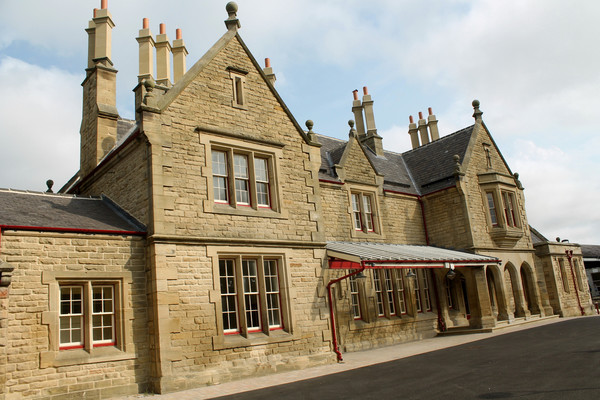
Morpeth
Berwick on Tweed
The station is located within the castle walls and was rebuilt between 1913 and 1927, it is listed grade 2 and has been fettled up recently. It stands on the site of the Great Hall where in 1292 Edward I imposed Baliol as King of the Scots. The adjacent engineering yard within the walls will shortly become a car park with access to view the walls. The despoliation of the castle in the late 1840’s was at least partly atoned for by the construction of the Royal Border Bridge designed by Robert Stephenson which towers over the river Tweed. It is grade 1 listed. In the yard is one of the cut out signs that line the East Coast Mainline, there are about 30 along the route and they are slowly reappearing with restoration funded by the RHT and often done voluntarily by maintenance engineers.
The excursion to Lindisfarne will pass over the East Coast railway Mainline at Belford, the site of one of a series of Jacobean inspired stations designed by Benjamin Green, a Newcastle architect who designed the Theatre Royal there as well as the Grey column. The station house is one of a series north of Newcastle, most of the stations are now closed but Morpeth is the largest, very much open, and has equally just won an NRHA award for its restoration and repurposing as rooms for start up businesses. The Laing Museum in Newcastle has his papers.
The other excursion takes in Alnwick where there is a very elegant one time station now repurposed as a second hand bookstore. It dates from 1887 and was designed for the North Eastern Railway by its in house architect William Bell, the grand scale no doubt influenced by the then Duke of Northumberland. Darlington is a contemporary, York and Newcastle are earlier.
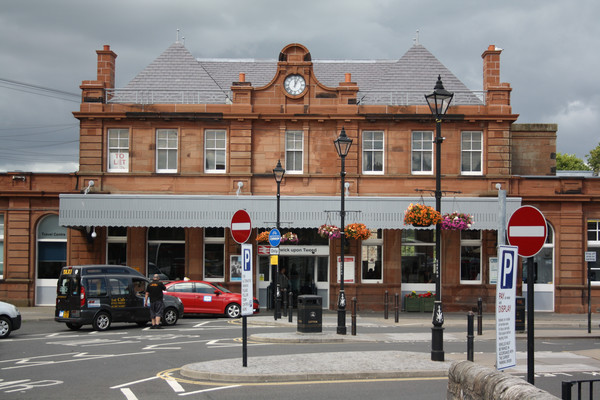
Berwick on Tweed
Whitby
The station at Whitby dates back to the 1840’s and is shared both by National Rail and the North Yorkshire Moors heritage railway, one of the longest in the country. It was one of many designed by GT Andrews who was one of the “Railway King” George Hudson’s architects (along with Francis Thompson and Benjamin Green) in the 1840’s. On the NYMR Grosmont and Pickering are other examples of his work. All have won NRHA awards at various times. Some of Andrews stations have distinctive overall roofs (Beverley and Pocklington are examples – the latter is now the school gym!!); the roof at Pickering is a modern copy of the original.
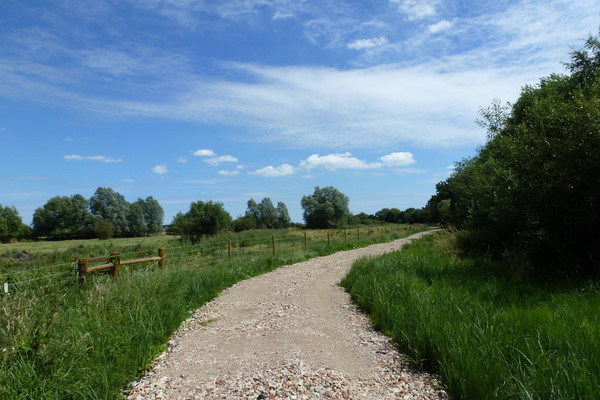
Wenhaston in Suffolk trackbed
Southwold
There was a narrow gauge railway from Southwold to Halesworth from 1879 to 1930; efforts are being made to restore it and there is a museum in the town. The restoration includes fencing out at Wenhaston which was one of the smaller entries to the NRHA competition, judging it involved a bucolic walk along the River Blythe! Since starting to write this piece we have another entry of an old goods shed which was being used as a barn at Blytheburgh.
The excursions will involve crossing the East Suffolk Railway at Darsham and Melton (for Sutton Hoo) stations both of a distinctive style of building and designed in the late 1850’s by Francis Thompson, who was born at Woodbridge. They are both repurposed – Melton as a butchers. That at Wickham Market is now a community resource with a coffee shop and won an NRHA prize a few years back. The stations started as white brick but have often been rendered. There are others repurposed at Framlingham, Snape, Glemham and Leiston on closed lines to instance a few. Thompson designed Chester station and some other North Wales stations in the 1840’s, before having a spell in Canada.
Stretching the definition to include NC hotel holidays Aldeburgh station has been lost to modern housing and Somerleyton Hall was rebuilt by Sir Morton Peto who built the railway to and station at Lowestoft with a station house at Somerleyton to match the Victorian Hall.
Portsmouth
I will include departure and arrival points. Portsmouth Harbour is mainly Southern Railway art deco, designed in 1937 by Rob Scott who was their chief Architect from 1923, it was reconstructed after war damage. One of his earliest designs is the Victory Arch war memorial at London Waterloo,100 years old in 1922. En route to Portsmouth are Surbiton, Woking and Havant among his many others. There is a series of gothic smaller stations designed by Sir William Tite (designer of London ‘s Royal Exchange) south of Guildford. Carlisle and Perth are among Tite’s other stations are nearly all in gothic style (in total contrast to the Classical Royal Exchange.
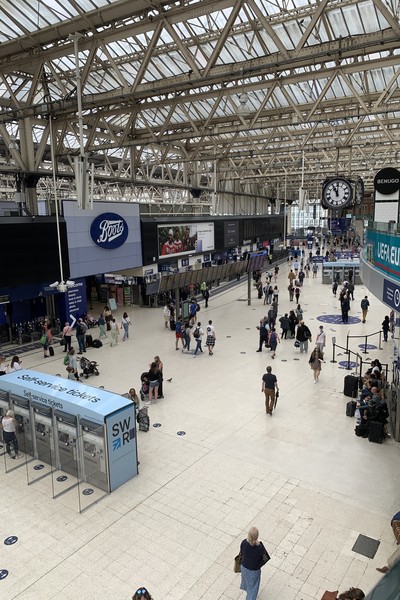
Waterloo
Kingswear and Dartmouth
These are both Great Western stations – one solely a ferry terminal – Kingswear now lovingly restored by the Paignton and Kingswear railway. The line was opened in 1866 and has been in private hands since 1972. Kingswear station was expanded in 1928 and the Torbay Express used to run directly to/from Paddington.
Plymouth
This was rebuilt between 1935 and 1960, with the main entrance area bombed and then built to match the postwar town centre. The tower is similar to the civic HQ. Opened (yes really!) by Dr Beeching in 1962, the station focussed traffic from 2 others at Millbay and Friary which were closed. Ocean liner specials operated between the wars to London save a day in transit. The designers were Howard Kavagnah and Ian Campbell and it is a good example of BR’s modernisation plan 1950’s work.
It would be remiss not to mention Brunel’s last work, the Royal Albert Bridge built at great height over the Tamar to link to Cornwall and opened in 1859. It is grade 1 listed.
Swansea
The station dates from the late 1934 and was built using government economic and unemployment relief funds.
Fishguard and Holyhead
Fishguard was opened by the Great Western Railway to replace Neyland as its Irish ferry terminal in 1898. It was developed as a time saving port for Trans Atlantic liners in the early 1900’s but never really reached its potential. There are still Irish ferries with connecting trains at Fishguard.
The railway reached Holyhead in 1848. Part of the station dates from 1866 and is a typical London and North Western Railway trainshed. The ferries used to moor adjacent. The rest of the station dates from the 1980’s.
The Britannia Bridge was a tubular construction designed by Robert Stephenson and opened in 1850. It was rebuilt after a fire in 1970 to take the A5, which until then had used Telfords lower level bridge. The Conway rail bridge is a similar tubular construction bridge to the original dating from the same era. Conway is another railway through a castle situation!
The Menai Bridge was rebuilt in the 1980’s as a 2 deck bridge carrying the railway on one deck and the A5 on the other. There are ornamental lions marking the entrance.
Llandudno
Another LNWR station dating from 1892, complete with cobbled carriage road and with some of the overall roof remaining. The restoration was part funded by the RHT.
Bodnant Gardens are near the Conway Valley railway line which is a very rural railway and which has been often closed due to flooding recently.
Liverpool
Changes in itineraries mean that Liverpool now makes the list!
Liverpool Lime St station was first opened in 1836 and gave a city centre terminal for the railway. The trainsheds date from the 1860’s/1870’s and contribute to the marvellous St. George’s Square Victorian collection of buildings. The frontage has been opened out and is a stunning feature. The student flats were originally a railway hotel and were designed by Alfred Waterhouse.
There was a station on the riverfront for shipping passengers but this was closed in the 1960’s. Liverpool has an Underground railway. At St James Street there is a well restored redundant platform and an Edwardian entrance passage. The campanile visible in Birkenhead is a feature of the station. St George’s Square is a must see architectural feature in Liverpool and the station buildings are worthy components.
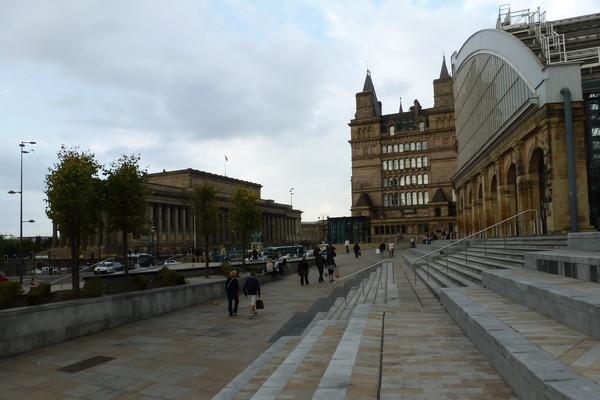
Liverpool Lime Street Station
Barrow in Furness
The station here was built in the 1950’s to replace the original Furness railway station, complete with overall roof. It was revamped in the 2000’s.
There are two complete Furness Railway stations at Grange over sands and Ulverston which are both listed. They were two of a series designed by Paley and Austin who ran a successful Lancaster architectural practice most renowned for their many church buildings in the Northwest.
Portrush
The station is modern but part of the much more substantial 1909 tudoresque station is adjacent.





